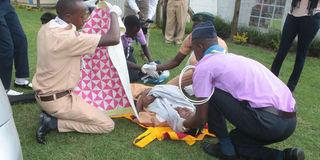Kenya, Tanzania test ability to deal with cross-border disease outbreaks

Kenya scouts performing a mass casualty incident drill at the Nakuru Level Five Hospital in October 2017.
Every day, the Namanga border post, dividing Kenya and Tanzania is a hive of activity, with people trooping in and out of one to another. This is why it was picked as the site for a field simulation, an interactive technique of evaluating risk preparedness, to review the capacities of the two countries to prepare and respond to cross-border disease outbreaks.
Dressed in white full personal-protection suits, teams of scientists drawn from the human and animal health fields conducted a week-long simulation to test how swiftly both countries would respond to potential outbreaks.
The team visited villages, abattoirs, and laboratories where samples drawn from travellers suspected to be infected are tested.
Using Rift Valley fever, a zoonotic disease, which has the potential to jump from animals to people, as an example, the exercise tested whether Kenya’s contingency plans were up to date and if personnel followed the laid down standard operating procedures.
“The cost of not being prepared is so hefty. For instance, recently there was an outbreak of Kala-azar that affected 1,200 people and cost the ministry Sh30 million to send teams of investigators to the ground. Now imagine if an outbreak occurred without proper preparation,” explained John Wekesa Masasabi, the acting director general at the Ministry of Health.
NEED FOR COORDINATION
“Drawing from what we witnessed in West Africa, there is a need for a coordinated response. Look at it from a relay perspective. It only takes one runner to drop their baton for the whole team to lose the run. If we do not work together, we will not be able to address this upsurge of outbreaks,” said Trade and Industry Cabinet Secretary Adan Mohammed at the launch of a three-day simulation exercise in Namanga.
The United Nations Development Programme estimates that for each dollar spent on preparedness, Sh700 is saved in the response to emergencies such as natural disasters, road accidents, or infectious disease outbreaks.
Simulations allow authorities to test capability to respond to the simulated situation, and to identify strengths and gaps for corrective actions at all levels – national, regional, community and global.
Simulations help to identify and address gaps in response capacity before an actual emergency occurs by enabling people to practise their roles and functions and to gain experience in simulated emergency settings.
“Preparedness is the ability to effectively anticipate, respond to, and recover from the negative impacts of a wide range of public health threats,” said Dr Tigest Ketsela Mengestu, WHO Country Representative for Tanzania.
IDENTIFYING WEAKNESSES
“The simulation will help us identify weaknesses and areas for further improvements in our response system and help us identify the strengths that need to be sustained,” he added.
Drawing about 150 experts, the Sh122 million exercise was convened by the East African Community Secretariat, with support from the World Health Organisation, the Food and Agriculture Organisation (FAO), and the German development agency, GIZ. Representatives from East African Community partner states – Burundi, Rwanda, South Sudan, and Uganda – participated as as observers.
“During the Ebola outbreak, WHO learned that there were difficulties in managing an outbreak of such magnitude and from that experience, a number of policies were formulated to improve our response. The simulation, therefore, aims to build and enhance the necessary capacities to minimise the risk of an incident becoming a crisis, and in the event of an emergency, improve the ability of teams to correctly assess and respond,” explained Allan Bell, a WHO specialist consultant.
Besides checking the efficiency of response, the simulation also sought to test the One Health approach, a collaboration of multiple sectors, ministries, and governments working locally, nationally and globally to attain optimal health for people, animals, and the environment.
The One Health approach is meant to foster coordination between different sectors, and ministries bringing together human and animal health experts, and security personnel to combat an outbreak.
Expert observers will assess and release the results of the simulation at a later date.



